SUBFAMILY MYRMICINAE - Genus Camponotus Emery
| The Ants
of Egypt SUBFAMILY MYRMICINAE - Genus Camponotus Emery |
In Tribe CAMPONOTINI.
Diagnostic Features - Polymorphic. Antennae 12-segmented, inserted some distance behind the posterior clypeal margin. Frontal carinae converging anteriorly, leaving the antennal insertions only partially or not at all covered. Eyes present, usually well developed and situated behind the midlength of the head. Clypeus often with a median portion projecting as a truncated lobe, more obvious in larger workers. Mandibles with five to seven stout teeth. Promesonotal suture distinct, development of other sutures variable. Alitrunk unarmed. Petiole a node or scale, unarmed. Acidopore circular and clearly visible.
Mayr's (1861) genus description is at ![]() .
.
Finzi (1936: 189ff) listed only three species definitely known from
Egypt -
fellah - including xerxes as reported by Karavaiev
(1911: 11)
aegyptiaca (including maculatus determined by Forel
(1908: 16) and Karavaiev (1911: 10)
sericeus.
He also reported a single worker from Hamman, 15.iii.1935, which might
be a variety of rufoglaucus.
Walker (1871: 170) described Camponotus pilaeogaster; this minor specimen is not obviously any of the better described species and was not listed by Bolton (1995: 117)..
A very large, complex genus, which is taxonomically confused and in great need of revision. Subgenera known from Egypt are shown below -
| ¤ | 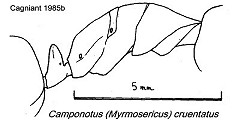 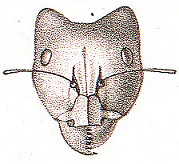 Myrmosericus
Forel (1912i: 91) - clypeus carinate, with pronounced anterior, usually
rectangular, lobe (as Tanaemyrmex); tibiae laterally compressed
with a longitudinal groove Myrmosericus
Forel (1912i: 91) - clypeus carinate, with pronounced anterior, usually
rectangular, lobe (as Tanaemyrmex); tibiae laterally compressed
with a longitudinal groove |
Camponotus. (Myrmosericus) |
| -- | 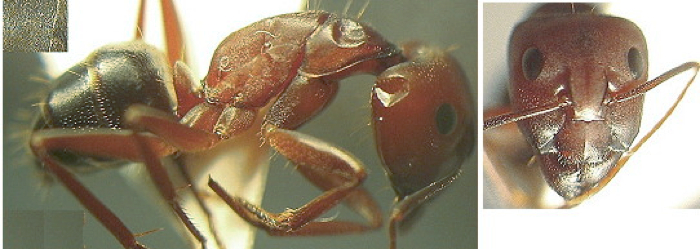 Integument entirely
opaque; very finely sculptured, silky and more or less covered with
rather abundant pilosity, especially the gaster; base colour matt black
or brown, but posterior and ventral areas of alitrunk, coxae and most
of femora, petiole and dorsum of first segment of gaster ferruginous
red; TL 6-14 mm; nest in earth or sand (description after Emery 1916b:
230) Integument entirely
opaque; very finely sculptured, silky and more or less covered with
rather abundant pilosity, especially the gaster; base colour matt black
or brown, but posterior and ventral areas of alitrunk, coxae and most
of femora, petiole and dorsum of first segment of gaster ferruginous
red; TL 6-14 mm; nest in earth or sand (description after Emery 1916b:
230) |
C. (Myrmosericus) cruentatus |
| -- |  Wholly dark, near black;
TL 6.8-12 mm Wholly dark, near black;
TL 6.8-12 mm |
C. (Myrmosericus) micans |
| ¤ | 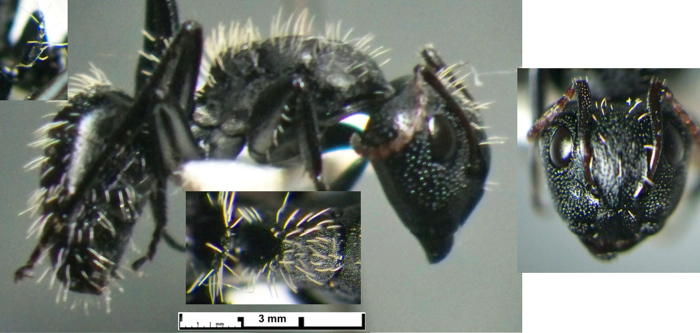 Myrmotrema MyrmotremaForel (1912i: 91) - head as in Orthonotomyrmex, major very broad posteriorly, minor trapezoidal, broadened posteriorly; thorax with or without dorsal notch; in major and queen anterior of head covered with deep round pits. C. rhamses workers TL 6.0-8.2 mm; totally black except for apices of appendages which are red-brown; densely puncturate and matt, fossettes on head small and spaced out but found right up to the occiput; gaster with golden pubescence but not so dense as to hide the sculpture; erect hairs slender and clear yellow |
C. (Myrmotrema) rhamses |
| ¤ | Orthonotomyrmex Ashmead (1906: 31) - as a rule of a heavy build, with opaque integument, sometimes silky or with a few short, coarse, obtuse hairs. Head of major very broad posteriorly. Head of minor trapezoidal, broadened behind. Clypeus with or without median lobe. Pronotum variably margined; dorsum of thorax usually with metanotal groove, in the form of a notch, sometimes reduced to a deep line; propodeum margined on sides and behind, sometimes rounded. Petiole node squamiform or nodiform, summit always smooth edged |
Camponotus (Orthonotomyrmex) |
| -- | 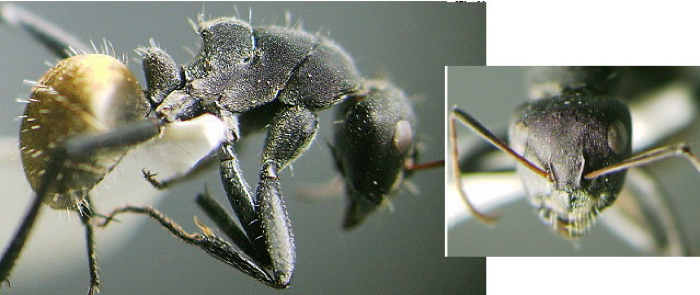 TL 8-10 mm; antennae generally more slender (except in
largest workers); anterior margin of clypeus with longer, finer fringe
of forward projecting hairs; dorsum of propodeum without an obvious
median longitudinal carina, in profile relatively short and more
convex, the propodeal spiracle is placed almost on the margin of the
declivity; petiole node relatively thin with smooth edges but
emarginate; sparse erect pilosity and reduced pubescence, except on
gaster; base colour deep somber red; gaster pubescence bright golden TL 8-10 mm; antennae generally more slender (except in
largest workers); anterior margin of clypeus with longer, finer fringe
of forward projecting hairs; dorsum of propodeum without an obvious
median longitudinal carina, in profile relatively short and more
convex, the propodeal spiracle is placed almost on the margin of the
declivity; petiole node relatively thin with smooth edges but
emarginate; sparse erect pilosity and reduced pubescence, except on
gaster; base colour deep somber red; gaster pubescence bright golden |
Egypt (type location), Sudan and eastwards into South Asia - C. (Orthonotomyrmex) obtusus - revived status |
| -- | 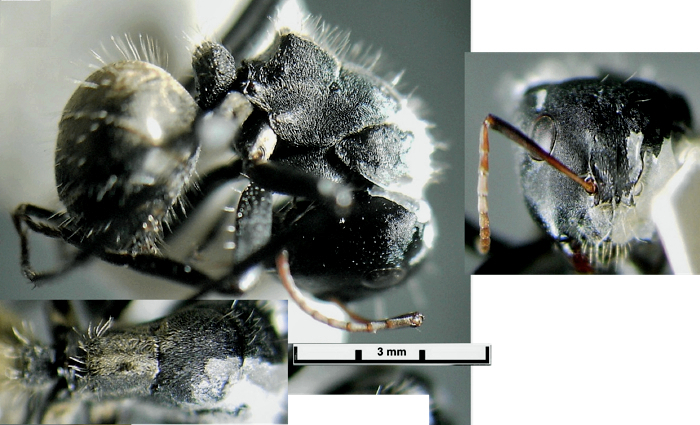 TL 8-10
mm; scapes somewhat shorter and thicker; propodeum usually with
longitudinal median carina and more sharply marginate, in profile
prodeum dorsum near flat, the propodeal spiracle is set distinctly
forward of the margin of the declivity; petiole node thick and domed;
generally dull as very sharply and evenly reticulo-punctate; anterior
margin of clypeus with fringe of coarser, shorter, forward projecting
hairs; pubescence scanty on head, increasing posteriorly to gaster
where it is abundant and dull bronzy-golden; underlying body black,
basal third of scape and funiculus dark brown-red TL 8-10
mm; scapes somewhat shorter and thicker; propodeum usually with
longitudinal median carina and more sharply marginate, in profile
prodeum dorsum near flat, the propodeal spiracle is set distinctly
forward of the margin of the declivity; petiole node thick and domed;
generally dull as very sharply and evenly reticulo-punctate; anterior
margin of clypeus with fringe of coarser, shorter, forward projecting
hairs; pubescence scanty on head, increasing posteriorly to gaster
where it is abundant and dull bronzy-golden; underlying body black,
basal third of scape and funiculus dark brown-red |
Pan-African - C. (Orthonotomyrmex) sericeus |
| ¤ | Tanaemyrmex Ashmead (1905b: 384) - member species regarded as in Myrmoturba by Wheeler (1922); synonymized by Emery (1925b: 75) - clypeus carinate, with pronounced anterior median lobe (usually rectangular). Head of major usually much wider posteriorly, occiput usually without a border; minor head with parallel sides, sometimes narrowed posteriorly; mandibles usually with 6-7 teeth; thorax dorsum arcuate, rarely with propodeum slightly depressed and saddle-shaped. Usually nesting in ground or under stones (truly global with very many species). |
|
| 1 | Without gular hairs on
underside of head; clypeus with well-defined longitudinal carina |
2 |
| -- | With at least a few gular hairs on underside of
head; hind tibiae with a row of 6 plus spiny hairs or setae on the
flexor surface; clypeus with median carina obtuse and not reaching
anterior margin |
3 |
| 2 | 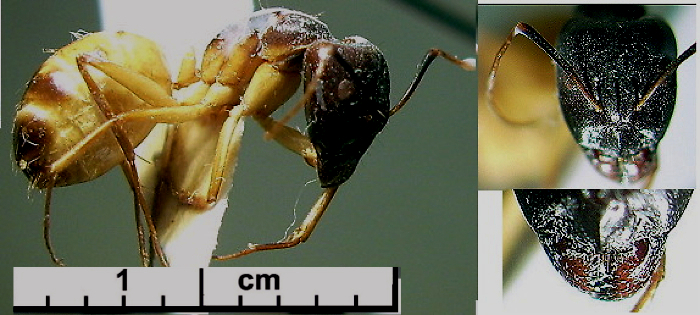 MAJOR TL > 11
mm; poly- or trimorphic, major only moderately sized; major head &
thorax uniformly dark brown, gaster with distinctive pattern of
yellow-brown patches; minors more predominantly yellow brown MAJOR TL > 11
mm; poly- or trimorphic, major only moderately sized; major head &
thorax uniformly dark brown, gaster with distinctive pattern of
yellow-brown patches; minors more predominantly yellow brown |
C. (Tanaemyrmex) aegyptiacus |
| -- | 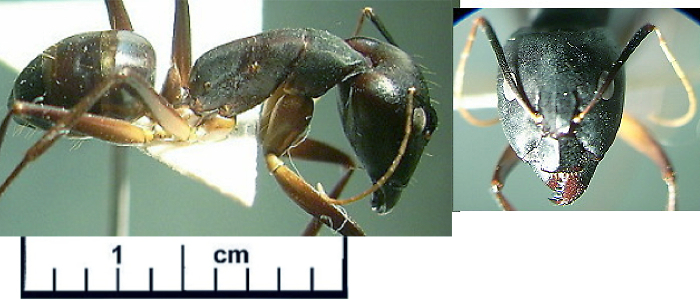 MAJOR TL 14
mm plus; fairly uniform reddish-brown; overall fine coriaceous
sculpture giving a matt appearance, gaster and occiput shinier; with
slender legs and antennae MAJOR TL 14
mm plus; fairly uniform reddish-brown; overall fine coriaceous
sculpture giving a matt appearance, gaster and occiput shinier; with
slender legs and antennae |
C. (Tanaemyrmex) cognatocompressus |
| -- |  MAJOR TL 14 mm;
mandibles with 6-7 teeth; clypeus with distinct median carina, anterior
extended to form a very wide, rectangular lobe with a straight border
body quite slender, very slender in small workers; shiny except for the
head in the majors; legs long, sometimes very long; whole of body very
finely rugose and punctuate; on head the rugae are stronger and the
punctures larger and more frequent; overall dark ferruginous, gaster
shiny black MAJOR TL 14 mm;
mandibles with 6-7 teeth; clypeus with distinct median carina, anterior
extended to form a very wide, rectangular lobe with a straight border
body quite slender, very slender in small workers; shiny except for the
head in the majors; legs long, sometimes very long; whole of body very
finely rugose and punctuate; on head the rugae are stronger and the
punctures larger and more frequent; overall dark ferruginous, gaster
shiny black |
possibly not in Egypt - C. (Tanaemyrmex) sylvaticus |
| -- | 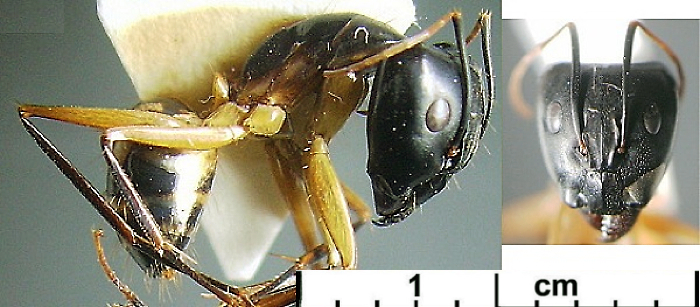 MAJOR TL 14
mm plus; very variable in colour and size, enormously plastic species
(type form in photo). MAJOR TL 14
mm plus; very variable in colour and size, enormously plastic species
(type form in photo).Egypt records - possibly not found as niche filled by C. aegyptiacus; Karavaiev (1911: 10) reported finding major and minor workers and wingless queens from Cairo but he noted the queens had parallel sided heads matching the type queens in Emery (1908a: 192). However, Sharaf list - Abuzabal (Qalyubiya), 13.vi.2003 (2); Abuzabal (Qalyubiya), 14.vi.2003 (1); Abuzabal (Qalyubiya), 14.v.2003 (1) (SHC). Local distribution: Nagh Hammadi, Salloum, Kantara. The link is to the page on Ants of Africa. |
possibly not in Egypt - C. (Tanaemyrmex) maculatus |
| 3 | 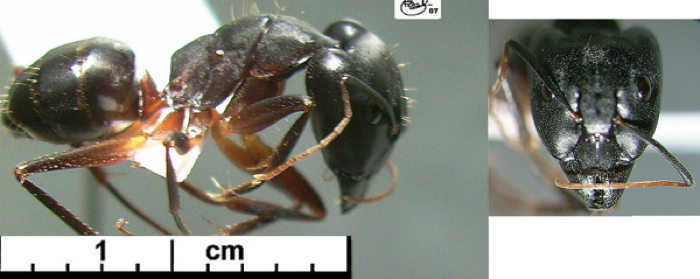 MAJOR TL ca 15 mm; HW
4.3 HL 3.9 mm; underside of head with a few gular hairs; mostly dark
brown, alitrunk yellow (particularly on minors), funiculus, petiole,
rust patches on gaster MAJOR TL ca 15 mm; HW
4.3 HL 3.9 mm; underside of head with a few gular hairs; mostly dark
brown, alitrunk yellow (particularly on minors), funiculus, petiole,
rust patches on gaster |
C. (Tanaemyrmex) fellah |
| -- |  MAJOR TL 16 mm; dorsum
of petiole steeply rounded; head large, domed and short; appendages
relatively short and slender; almost entirely matt; minors with
prismatic tibiae MAJOR TL 16 mm; dorsum
of petiole steeply rounded; head large, domed and short; appendages
relatively short and slender; almost entirely matt; minors with
prismatic tibiaeMinor illustrated |
C. (Tanaemyrmex) oasium |
| -- |  MAJOR TL ca
15 mm; HW 4.8 HL 4.2 mm; scape 3.8-3.9 mm;
dorsum of petiole widely rounded to flat; head shiny; alitrunk, petiole
and first two segments of gaster yellow-brown, posterior of gaster and
head black-brown; nests in sandy ground - MAJOR TL ca
15 mm; HW 4.8 HL 4.2 mm; scape 3.8-3.9 mm;
dorsum of petiole widely rounded to flat; head shiny; alitrunk, petiole
and first two segments of gaster yellow-brown, posterior of gaster and
head black-brown; nests in sandy ground - |
C. (Tanaemyrmex) thoracicus |
| -- | 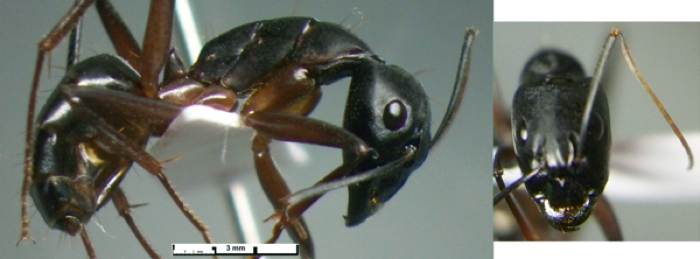 MAJOR TL 16 mm; dorsum
of petiole steeply rounded; head large, domed and short; appendages
relatively short and slender; almost entirely matt; minors with
prismatic tibiae MAJOR TL 16 mm; dorsum
of petiole steeply rounded; head large, domed and short; appendages
relatively short and slender; almost entirely matt; minors with
prismatic tibiaeMinor illustrated (part damaged major on species page) |
C. (Tanaemyrmex) adenensis |
|
©2006, 2010, 2015 - Brian
Taylor CBiol FRSB FRES 11, Grazingfield, Wilford, Nottingham, NG11 7FN, U.K. |
href="camponotus.htm"